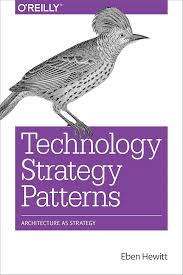Technology Strategy Patterns: A Comprehensive Guide
This white paper explores the concept of "Technology Strategy Patterns" as presented in the book by Eben Hewitt, published by O'Reilly Media. We will delve into the core principles, explore key patterns, and discuss their practical applications in today's rapidly evolving technological landscape.
1. Introduction
Effective technology strategy is crucial for businesses to thrive in the digital age. However, developing a winning strategy can be challenging due to the complexity and rapid pace of technological change. This white paper explores the concept of "Technology Strategy Patterns" – repeatable solutions to common technology challenges faced by organizations. By understanding and applying these patterns, businesses can make more informed decisions, accelerate innovation, and gain a competitive advantage.
2. Core Principles of Technology Strategy Patterns
- Recognizing Recurring Challenges: Identifying common technology-related challenges faced by businesses across various industries, such as digital transformation, data management, cybersecurity, and cloud adoption.
- Identifying Proven Solutions: Identifying and documenting successful approaches and best practices for addressing these challenges.
- Adapting and Applying Patterns: Adapting and applying these proven patterns to specific business contexts and requirements.
- Continuous Learning and Refinement: Continuously evaluating and refining technology strategy patterns based on emerging trends and new challenges.
3. Key Technology Strategy Patterns
- Digital Transformation Patterns:
- Cloud Migration: Strategies for migrating on-premises applications and data to cloud platforms (e.g., AWS, Azure, GCP).
- Data-Driven Decision Making: Patterns for leveraging data analytics and machine learning to improve business decisions.
- Customer Experience (CX) Transformation: Strategies for enhancing customer experiences through digital channels and technologies.
- Innovation Patterns:
- Innovation Hubs: Creating dedicated spaces and teams to foster innovation and experimentation.
- Agile Development: Implementing agile methodologies to accelerate software development and improve responsiveness to market changes.
- Open Innovation: Collaborating with external partners, such as startups and research institutions, to drive innovation.
- Security and Risk Management Patterns:
- Zero Trust Security: Implementing a security model that assumes no trust and verifies every request.
- Cybersecurity Incident Response: Developing and implementing robust incident response plans to minimize the impact of cyberattacks.
- Data Privacy and Compliance: Strategies for ensuring compliance with data privacy regulations (e.g., GDPR, CCPA).
- Cloud Computing Patterns:
- Cloud-Native Applications: Designing and developing applications specifically for cloud environments.
- Serverless Computing: Utilizing serverless functions to reduce operational overhead and improve scalability.
- Microservices Architecture: Decomposing applications into small, independent services for improved agility and scalability.
4. Use Cases of Technology Strategy Patterns
- A retail company can utilize the "Data-Driven Decision Making" pattern to analyze customer data and personalize marketing campaigns.
- A manufacturing company can leverage the "Industrial IoT" pattern to connect their machines and equipment to the internet, enabling predictive maintenance and improved operational efficiency.
- A financial institution can adopt the "Cybersecurity Incident Response" pattern to minimize the impact of cyberattacks and protect sensitive customer data.
- A healthcare provider can implement the "Telehealth" pattern to provide remote patient care and improve access to healthcare services.
5. Benefits of Applying Technology Strategy Patterns
- Accelerated Decision Making: Provides a framework for making informed technology decisions quickly and efficiently.
- Reduced Risk: Mitigates the risk of costly mistakes by leveraging proven solutions and best practices.
- Improved Innovation: Fosters a culture of innovation and experimentation within the organization.
- Enhanced Agility: Enables organizations to adapt quickly to changing market conditions and technological advancements.
- Increased Efficiency: Streamlines technology operations and improves resource utilization.
6. References
- "Technology Strategy Patterns" by Eben Hewitt (O'Reilly Media)
- "The Innovator's Dilemma" by Clayton M. Christensen
- "Competing on Analytics: The New Science of Winning" by Thomas H. Davenport and Jeanne G. Harris
- "Cloud Computing: Principles and Paradigms" by Rajkumar Buyya, Chee Shin Yeo, and S. Venugopal
- "Designing Data-Intensive Applications" by Martin Kleppmann
Disclaimer: This white paper provides a general overview of Technology Strategy Patterns. The specific application and effectiveness of these patterns will vary depending on the individual needs and circumstances of each organization.
This information is for general knowledge and informational purposes only.



